In 2025, you’ll see the chemical industry driven by steady growth, especially in Asia-Pacific, with a focus on sustainability and innovation. Challenges like energy volatility, inflation, and geopolitical tensions remain, but digital transformation and advanced technologies such as AI and automation help navigate these. Opportunities abound in green products, batteries, and recycling, while talent development becomes essential. To understand how these trends shape your future landscape, explore further insights ahead.
Key Takeaways
- Global chemical production is expected to grow by 3.5% in 2025, driven by Asia-Pacific and emerging markets.
- Sustainability initiatives and green innovations are becoming key differentiators for industry players.
- Digital transformation, including AI and automation, enhances efficiency, safety, and supply chain resilience.
- Geopolitical tensions and protectionist policies pose risks, prompting regionalization and supply chain diversification.
- Investment priorities focus on high-growth sectors like batteries, green hydrogen, recycling, and workforce digital skills.
Industry Growth Dynamics and Economic Outlook
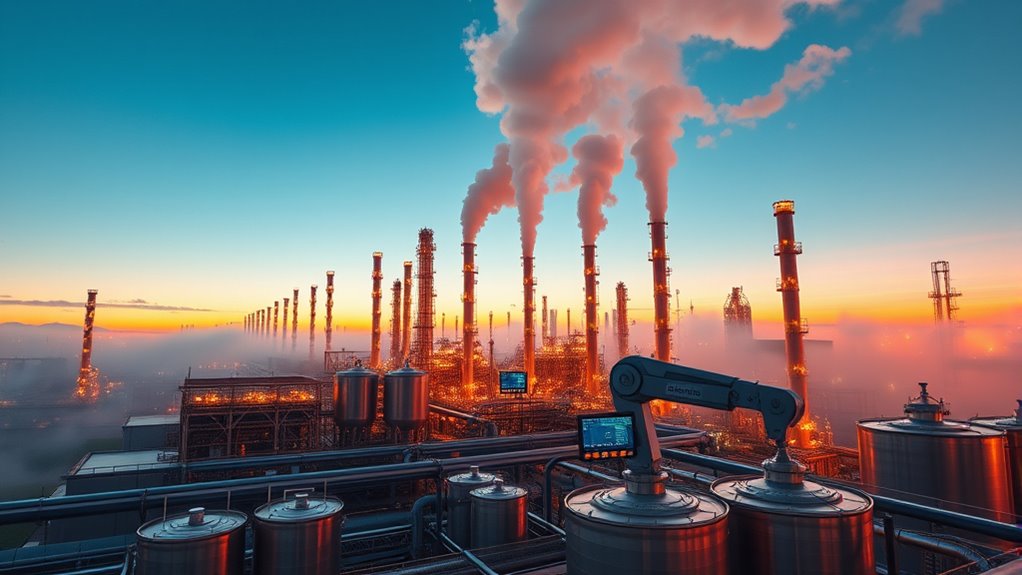
Despite ongoing challenges, the chemical industry is set to grow steadily in 2025, with global production projected to increase by 3.5%. You’ll notice this growth comes on the heels of a slight rebound from 3.4% in 2024 and a modest 0.3% in 2023, showing resilience despite uneven recovery. Demand is gradually returning across regions, with Asia-Pacific remaining the primary growth engine. Meanwhile, the US benefits from housing, manufacturing, and specialty chemicals, while Europe faces stagnation due to high energy costs and regulations. Construction activity, driven by rising housing starts, boosts chemical demand, and emerging markets like Latin America and Africa offer niche opportunities. However, persistent macroeconomic issues, such as energy volatility, inflation, and overcapacity, continue to challenge industry stability and margins. Global industrial production growth is expected to accelerate to 2.6% in 2025, supported by capacity expansions and favorable energy fundamentals, which will help sustain industry growth despite regional disparities. Additionally, market resilience is bolstered by innovations in sustainable and specialty chemicals that cater to evolving consumer preferences.
Sustainability as a Competitive Edge
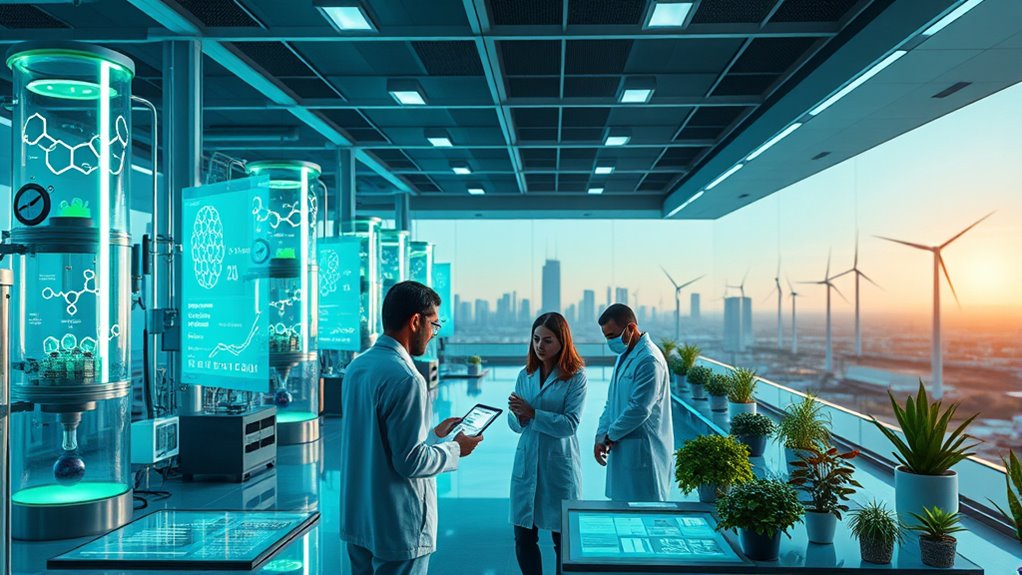
How is sustainability shaping the competitive landscape in the chemical industry in 2025? It’s becoming a key driver for innovation, helping you differentiate your offerings through eco-designed products and circular solutions like advanced recycling and bio-based feedstocks.
Companies leading in sustainable R&D gain advantages by meeting global environmental goals and expanding into green sectors such as battery materials and green hydrogen.
Emissions reduction efforts, driven by stricter regulations, are pushing you to improve energy efficiency and transparency.
As sustainability becomes integral to regulatory compliance, your ability to adapt—through enhanced EHS practices and clear labeling—affects market access.
Balancing innovation with cost competitiveness is essential, as integrating sustainability into your strategy can improve your market positioning and future-proof your business against evolving consumer and regulatory demands.
Understanding the role of color accuracy in your products can also give you an edge in the market, as consumers increasingly demand high-quality, environmentally responsible solutions.
Technological Advancements and Digital Transformation
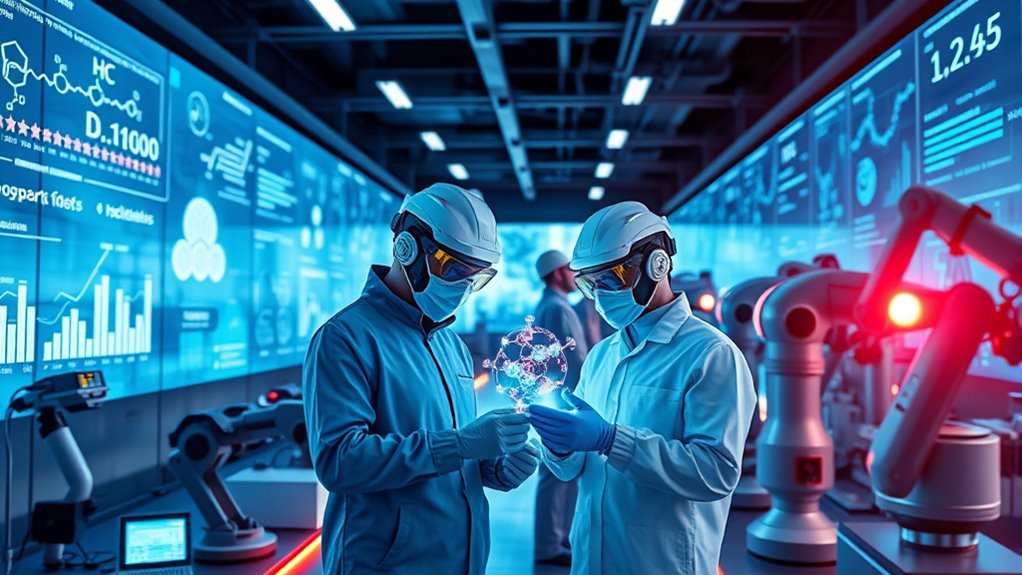
Technological advancements and digital transformation are reshaping how the chemical industry operates, driving efficiency and innovation at every stage. AI-driven process optimization enables real-time reaction monitoring, predictive maintenance, and energy savings, reducing waste and lowering costs. The industry has seen consistent investments in digital tools, reflecting a shift toward more data-centric operations. Automated systems maintain production consistency by precisely controlling temperature and pressure, ensuring uniform quality. Digital customer engagement tools, like personalized platforms and supply chain dashboards, enhance transparency and responsiveness. Gen AI automates documentation, streamlines commercial processes, and models geopolitical risks, accelerating decision-making. Advanced automation solutions, including robotics and IoT sensors, improve safety, quality control, and warehouse management. Digital transformation also facilitates better supply chain management and inventory tracking, further optimizing resource allocation. R&D accelerates through high-throughput experimentation and AI analysis, enabling faster development of new products. Together, these innovations boost competitiveness and sustainability, positioning the industry for continued growth.
Navigating Market Challenges and Geopolitical Risks

Are geopolitical tensions and protectionist policies reshaping the global chemical landscape? They’re creating significant unpredictability in trade flows.
Increases in tariffs—up to 60% from China and 20% elsewhere—could cut global trade growth by 2.4 percentage points in 2026.
Trade disputes threaten $67 billion in exports from Europe and China to the US, heightening supply chain risks.
Political turmoil prompts companies to delay investments and rethink strategies. Many are regionalizing or localizing manufacturing to reduce exposure.
Meanwhile, supply and demand are shifting regionally, with slower Chinese growth and rising activity in Southeast Asia and Africa.
High energy prices, especially in Europe, push firms to relocate or downsize operations.
Digital tools like AI help improve supply chain visibility amidst this volatility, but talent shortages and energy costs remain critical obstacles.
Implementing cybersecurity measures and encryption solutions can help protect sensitive data and communication channels during this period of increased geopolitical risks.
Strategic Investment Priorities for Future Growth
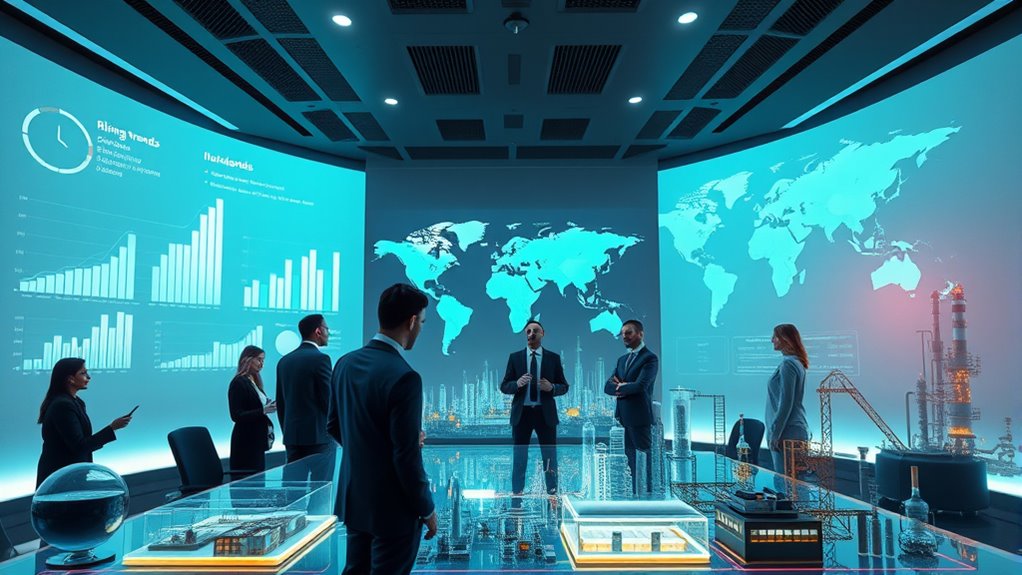
To position for long-term growth, companies in the chemical industry are prioritizing strategic investments in innovation, sustainability, and digital transformation.
Digital innovation, including generative AI and predictive analytics, is vital for boosting operational efficiency and customer engagement.
Focus on high-growth sectors such as batteries, green hydrogen, and alternative fuels offers new opportunities for chemical applications.
Additionally, recycling efforts are expanding to secure resource stability and reduce environmental impact.
Emphasizing sustainability and supply chain resilience will help you meet stricter regulations, gain competitive advantages, and prepare for a low-carbon, high-tech future.
Furthermore, understanding Fokos can provide valuable insights into industry trends and emerging technologies that support these strategic priorities.
Workforce Evolution and Talent Development
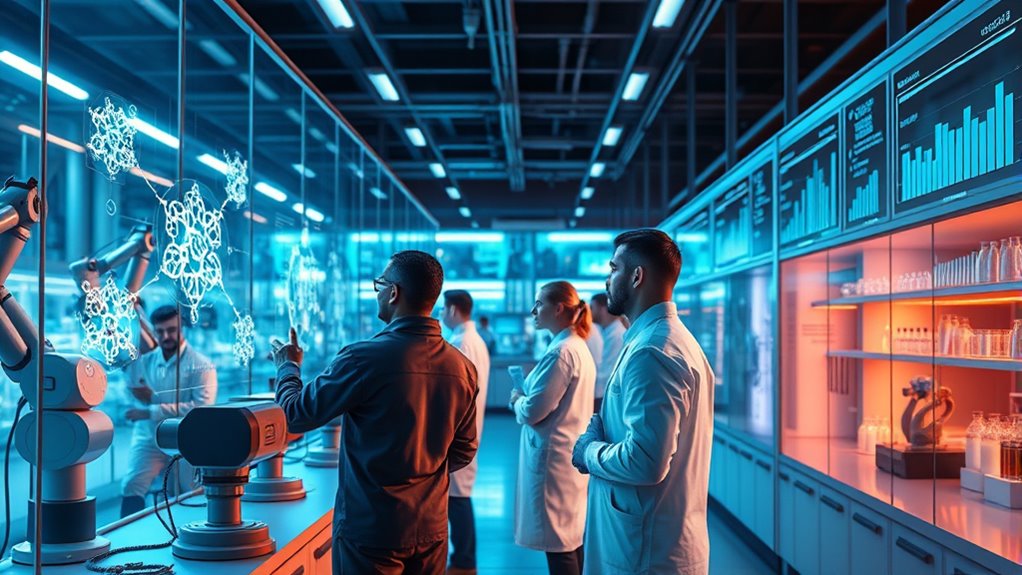
As chemical companies prioritize innovation and sustainability, they must also address evolving workforce needs. High energy costs in Europe are causing plant closures, disrupting employment and requiring new talent strategies.
Skilled labor shortages, especially in technology and R&D, demand targeted talent development. Companies are investing in digital skills, AI expertise, and decarbonization knowledge to stay competitive.
Generative AI and digital tools are transforming R&D and operations, making digitally skilled professionals more valuable.
Regional shifts, like U.S. and Middle East growth, create new talent demands aligned with global supply chains.
Future opportunities lie in circular economy initiatives, high-tech innovations, and sustainable products, all requiring specialized talent.
Developing versatile, tech-savvy workforces is essential for steering the industry’s evolving landscape, and understanding QA testing practices can help ensure quality in complex processes.
Frequently Asked Questions
How Will Emerging Regulations Impact Chemical Industry Innovation Strategies?
Emerging regulations will markedly shape your innovation strategies by pushing you to prioritize sustainable, non-PFAS alternatives and safer chemicals. You’ll need to incorporate regulatory risk assessments early in product development, ensuring compliance across different regions.
This regulatory landscape encourages collaboration with regulators and suppliers, fostering safer chemical innovations. Staying adaptable and proactive helps you navigate uncertainties, seize market opportunities, and maintain competitive advantage in a rapidly changing, compliance-driven environment.
What Are the Most Promising New Sustainable Materials in Development?
You’re exploring promising new sustainable materials, and bio-based polymers like PLA and PHA stand out, offering biodegradability and lower carbon footprints.
Green feedstocks such as bioethanol and recycled materials are transforming energy storage and electronics, with innovations in solid-state batteries and conductive polymers.
Additionally, Safe and Sustainable-by-Design materials are gaining attention, minimizing toxicity and supporting circular economies.
These developments align with industry goals to create eco-friendly, efficient, and safer products.
How Can SMES Compete in a High-Tech, Sustainability-Driven Market?
Steering the evolving landscape, you can stay competitive by embracing innovation and focusing on sustainability.
Invest in green technologies and digital tools to boost efficiency, while forming strategic partnerships to access new expertise.
Simplify compliance through supporting EU initiatives and explore niche markets to stand out.
With government incentives and a commitment to continuous improvement, you’ll turn challenges into opportunities, ensuring your business thrives in this high-tech, sustainability-driven market.
What Role Will Artificial Intelligence Play in Future Chemical Manufacturing?
You’ll see AI play a pivotal role in future chemical manufacturing by optimizing processes in real-time, reducing waste, and boosting yields. It’ll predict equipment failures, minimize downtime, and enhance safety through automation.
AI will accelerate R&D, enabling you to develop innovative, eco-friendly chemicals faster. By automating quality control and safety measures, it helps you stay compliant and competitive.
Ultimately, AI will transform your operations into smarter, more efficient, and sustainable systems.
How Are Companies Managing Supply Chain Disruptions Amid Geopolitical Tensions?
Picture your supply chain as a tightrope walker balancing amidst storms. To manage disruptions during geopolitical tensions, you’re leveraging digital tools like real-time monitoring and predictive analytics to stay steady.
You’re diversifying suppliers and reshoring production to reduce risks, while forging strategic partnerships for resilience.
Conclusion
As you navigate the evolving landscape of the chemical industry, envision yourself steering a ship through both turbulent waters and clear skies. Embrace innovation and sustainability as your compass, guiding you toward new horizons. By staying adaptable and investing wisely, you’ll transform challenges into opportunities, turning the industry’s future into a vibrant tapestry of growth and resilience. The journey ahead is yours to shape—so set your course with confidence and purpose.









